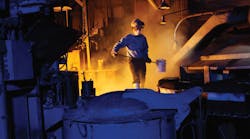As 2017 closes and 2018 approaches, any reliable evaluation of U.S. industrial and manufacturing economics will portray a positive outlook. But economics is unstable, and unpredictable; business conditions are prone to sudden reversals, a condition that has been made more volatile, not less, by the wider availability of data and the immediate pace of communication in the current age. More than this, a general analysis of economics becomes less relevant and reliable as the discussion narrows on particular market sectors and industries.
This is the reason the Foundry Management & Technology undertakes to survey metalcasters on an annual basis – to gauge their perceptions and predictions of the current and developing conditions in their business sector.
Of course, metalcasters are an irreplaceable part of the industrial economy, and are influenced by the overall conditions. In the most recent edition of the Institute for Supply Management’s Manufacturing Report, economic activity in the manufacturing sector was found to have expanded during October, as the wider U.S. economy expanded for the 101st consecutive month. The ISM New Orders Index for manufactured goods was found to have declined slightly (-1.2%) from September; and a comparable decline (-1.2%) from September was reported in the ISM Production Index.
Such declines seem to be negligible at the moment — after all, 16 of 18 manufacturing industries making up the ISM index expanded during October, including transportation, machinery, and primary metals. But, the greater problem for an individual seeking to understand the effects of such trends is the accelerating influence of high technology at the production levels of manufacturing, and the increasing autonomy of individuals making decisions in these operations.
The challenge in economic forecasting has always been to derive and apply timely information, and that is even more relevant in an age of accelerated communication. But, the forecasts perform different functions for manufacturing operators and strategists than for investors or financial analysts. Both types need information in order to make critical decisions, but for operators like metalcasters the decision must be made in a competitive setting, informing their innate understanding and judgement of conditions in their businesses. That is the objective we set for the Foundry Management & Technology Business Outlook survey.
How it works — Every October, FM&T surveys metalcasters to capture the insights, concerns, and expectations of men and women working in North America’s foundries and diecasting plants. We seek to understand not only the current operating circumstances for these enterprises, but also the underlying conditions shaping the businesses, and how these are received and understood by the industry’s decision-makers. We want to take account of the problems the they face in their businesses and the economy, to learn what plans they’re making for the coming business cycle, and to understand better their expectations for the year now approaching.
We surveyed readers by email over a period of four weeks. The results include responses from dozens of readers who represent the full variety of foundries and diecasters: 20.9% named steel (of any alloy or quality) as the principle metal cast at their plant; 19.8% cast mainly gray iron. Ductile iron foundries comprise 16.3% of the respondents; casting aluminum alloys is the main line of business for 18.6% of respondents. While brass and bronze alloys represent 9.3% of the respondents, 15.1% of the respondents cast alloys categorized as “other,” which may include magnesium, titanium, stainless steel, or some other unidentified material.
Similarly, the survey is designed to portray the full scope of operations active in metalcasting today: 26.7% of the survey respondents are employed at large foundries, with over 250 employees; 24.4% are attached to businesses with 20 to 49 employees; and 19.8% are employed at businesses with less than 20 employees. Another 16.3% are employed by businesses with 50 to 99 employees; and 12.8% are at work for businesses with 100 to 249 workers. Thus, as with the distribution of the metals being cast by the survey respondents’ plants, the full spectrum of employment conditions and concerns are reflected in the survey results.
Sense of place — We started the Outlook survey by establishing the respondents’ sense of recent and current metalcasting business conditions — using 2017 casting shipment volumes (tonnage) as a frame in which to characterize their estimations. The survey respondents are overwhelmingly positive about their current conditions, as 62.8% indicate the current year’s shipment totals will improve on the 2016 results. Beyond these, roughly a quarter (24.4%) of all respondents believe the 2017 results will be even with the 2016 results. Only 12.8% of the respondents report the current year’s shipment total will fall behind the 2016 results.
Among the larger, more optimistic respondents’ pool, a near-majority — 45% — estimates their 2017 shipment tonnage will rise by up to 10% over the 2016 tonnage; and a comparable number (45%) forecast the 2017 rise will be in the 10-25% range. Another 5.0% of respondents see the tonnage increase in the range of 26-50%; and 1.7% predict an increase above 90% for the current year.
As for the less optimistic respondents, 47.0% forecast their 2017 shipment declines will be in the 0-10% range; and another 47.0% forecast the decline will be in the 10-25% range.
The survey took the same approach to evaluate respondents sense of 2018 business prospects, again in terms of tons-shipped. Again, the optimists have the edge: 64.3% anticipate casting shipments volumes will rise during the year ahead, and 30.1% forecast the volumes will remain even with the 2017 totals. Just 4.8% expect 2018 casting shipments to fall below current-year results.
Among these responses, we found that the 47.0% of all respondents who foresee rising casting shipments totals in 2018, 50.8% expect that rise to be in the 10-25% range; 39.3% expect the rise to be in the 0-10% range; and 8.2% see the increase in the range of 26-50%.
There is more to learn from the FM&T 2018 Business Outlook Report.











